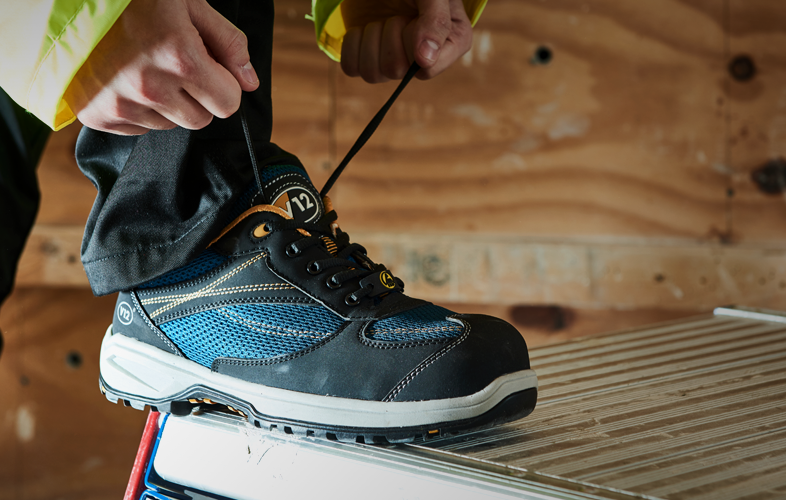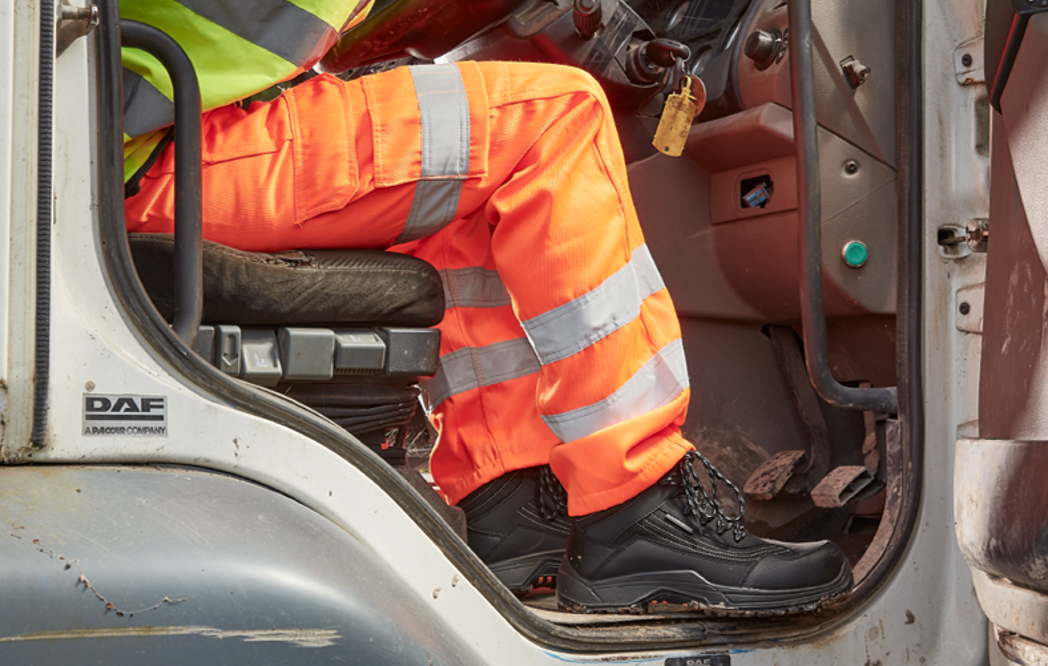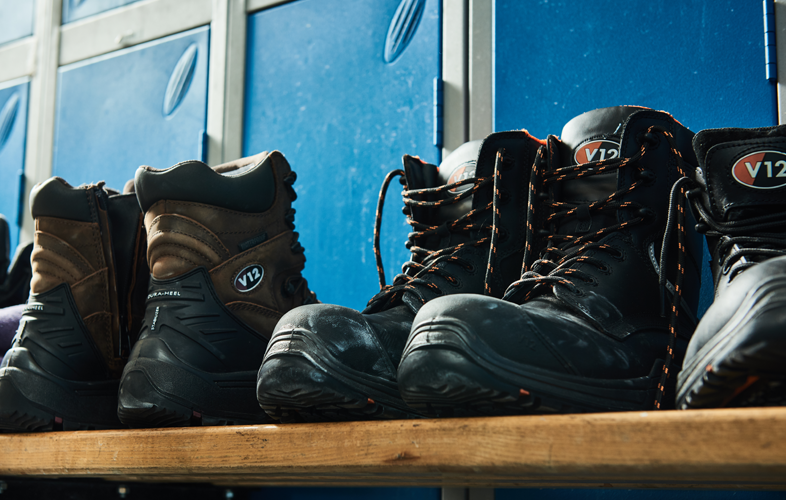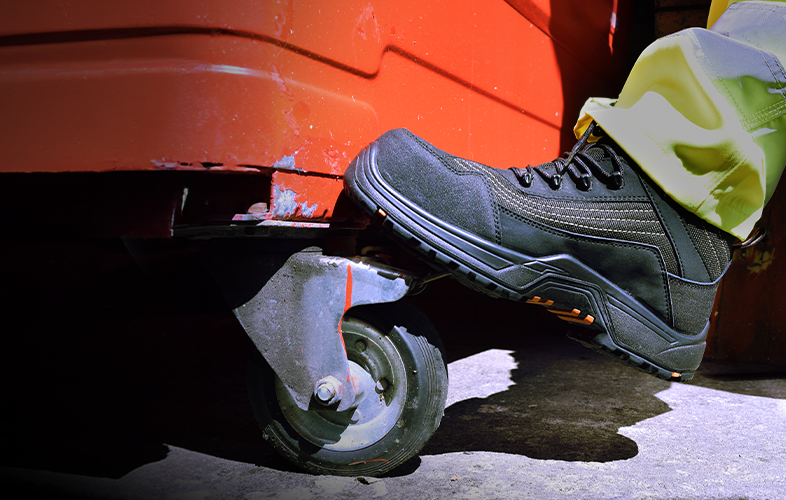“When we talk to wearers about their safety footwear experience, many say that their work boots hurt their feet. But what’s really sad is that so many believe this discomfort is to be expected, and that to endure heavy, hot and blistered feet on a daily basis is simply something to be put up with.”
V12 Footwear Co-founder, Andy Turner
And imagine how this discomfort is worsened by being in such boots for 8+ hours and taking thousands of steps per day.
But the reality is, with the correct safety footwear solution, there is no reason why work boots shouldn't be just as comfortable as standard shoes or trainers. And if you’re a safety distributor, you can unlock game-changing levels of performance and productivity for your customers if your safety footwear provision is built and designed for comfort and foot health.
So, what should you be looking for in a work boot range that fit and feel just like ordinary shoes?
IT ALL STARTS WITH FIT
Comfort is nothing without fit. Cushioning and padding are all very well, but if the footwear isn’t designed to contour the wearer’s foot shape, discomfort won’t be far around the corner.
This is why V12 Footwear - working with the only remaining British lastmakers in the country - developed their last using over 4,000 global foot scans, so both narrower and wider foot shapes are accommodated in our range.
Our men’s fit and True Women’s FitTM range are also both built on last shapes that each reflect the anatomical differences in foot shapes between the two sexes.
This ensures:
- No rubbing or chaffing
- No blistering, corns or calluses
- Improved musculoskeletal alignment
- Improved well-being and productivity
Pictured: In blue, the V12 comfort last. Note how much more contoured and sculpted the foot form is compared to the green generic last. It is these design nuances which provide a bespoke and snug fit.
Find out more about the V12 men’s and True Women’s FitTM last in this article.
Toecap width
 The toecap can be a common pain point for wearers, and is arguably the element of safety footwear that is quickest to remind the wearer they are not in standard shoes. With the wrong fitting boot, the toecap can rub or push against the toes, which not only causes discomfort, but can reduce the crucial clearance height which stops toes being crushed in the event of impact.
The toecap can be a common pain point for wearers, and is arguably the element of safety footwear that is quickest to remind the wearer they are not in standard shoes. With the wrong fitting boot, the toecap can rub or push against the toes, which not only causes discomfort, but can reduce the crucial clearance height which stops toes being crushed in the event of impact.
To provide comfort – particularly for people whose foot width is greater than the average - a well designed safety boot last will ensure the toecap offers a more generous fit, so the toecap is sufficiently wide enough to accommodate the feet, and not push or rub against the toes.
Fastening
It sounds like a simple enough piece of guidance, but fastening safety boots properly with laces or zips is another way to ensure that they feel snug and fit the feet appropriately. It’s very common for safety boot wearers to think that comfort means room, and while a boot shouldn’t be tight, feet should feel snug and secure in boots, and should never be slipping or sliding around in boots: this can cause rubbing, blisters and impact the wearer’s gait and musculoskeletal alignment.
For work boots to fit like standard shoes, they need to be laced like standard shoes - tightly and securely.
Want to find out about different safety boot lacing techniques? View the video below or explore the playlist:
MORE COMFORT FEATURES TO LOOK FOR
Weight REDUCTION
Offering safety boots that are lightweight is a vital way of enhancing comfort. Thanks to innovations in design and components, the days of heavy, chunky and limb-fatiguing safety boots are long-gone.
Safety boots must carry certain componentry which naturally makes them heavier than standard footwear, but manufacturers are constantly innovating to develop boots which reduce weight to increase comfort. They include:
- Lighter toecap and midsole material
- Lighter midlayer and sole polymers
- Weight-reducing upper alternatives
Learn more about what to look for in a lightweight safety boot in this blog.
Breathability
There’s nothing more distracting and uncomfortable than hot feet due to lack of breathability in safety footwear. So, it’s important that you’re offering safety boots designed with cooling and moisture-wicking properties, so comfort is achieved along with protection.
- Mesh uppers
- Breathable linings
- Air-cooling insoles
Pictured: V12 Footwear's V1940 Torque safety hiker, a boot which offers unbeatable comfort with breathable mesh uppers and heat-reducing air flow channels.
To find out more, read our blog on breathable safety footwear here.
Scooped collar
A boot that factors in small comfort benefits can be one that’s most effective, because when it comes to comfort, often these small details make the biggest impact. A boot with a scooped collar means the Achilles is still protected, but the upper material doesn’t extend so high, meaning when driving and carrying out ladder work, the wearer avoids rubbing or chaffing.
Shank
![]() The shank (pictured) is a small component that any high-performing safety boot should feature. It’s not a component that is visible, as it’s placed in a boot’s mid-layer, but it carries out a vital comfort role. Head to this blog to find out how it works to support the foot when walking.
The shank (pictured) is a small component that any high-performing safety boot should feature. It’s not a component that is visible, as it’s placed in a boot’s mid-layer, but it carries out a vital comfort role. Head to this blog to find out how it works to support the foot when walking.
GET THE RIGHT BOOTS
So now you’ve got a clear idea of what kind of features a safety boot needs to offer maximum comfort, whether you’re a safety distributor, a Health and Safety Manager responsible for footwear for your team, or if you’re buying safety boots for yourself, you can use the V12 Boot Finder to help you find the right safety boots.
Click below, adding in the details of your safety and comfort requirements, and we’ll give you instant, expert safety boot recommendations, and you can start building your reputation as a supplier of the safest and most comfortable work boots.







